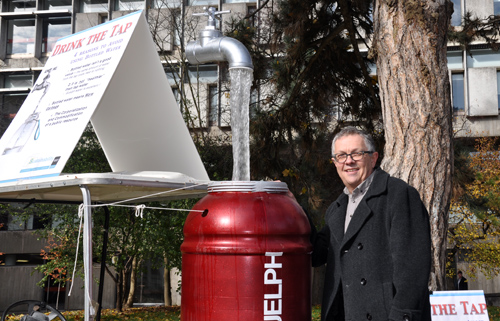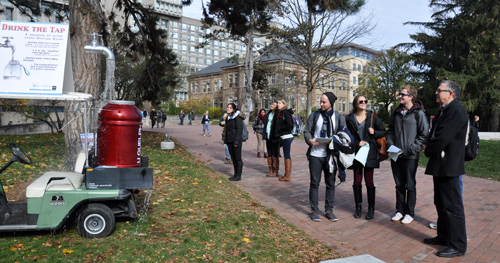
“Where’s the water coming from?” asked passersby when they saw an unusual display in Branion Plaza earlier this month. A faucet was filling a large aluminum barrel with water. What’s so special about that? The faucet didn’t appear to be connected to a water pipe. Instead, the faucet “floated” in the air as water gushed from the spout.
The display was designed to raise awareness of bottled water consumption on campus following a student-led campaign to ban the sale of bottled water at U of G.
“It’s just a way of drawing attention to the issue,” says Maurice Nelischer, U of G’s director of sustainability. He built the display based on a similar one he had seen in Europe. He says the display generated “unbelievable interest” on campus as pedestrians stopped to take photos, ask questions and talk about how they consume water.
“I would love to eliminate bottled water, but I’m not interested in banning it,” says Nelischer. “I’m interested in getting people to stop using it.” He wants to encourage the U of G community to use bottled water only when it’s absolutely necessary, such as on a road trip when nothing else is available. He admits that U of G sells “a significant amount” — about $400,000 worth in 2012 — of bottled water on campus, but he hopes consumers will think twice about the economic and environmental impact of their purchase.
A poster that accompanied the display listed concerns such as cost. Bottled water costs many times more than tap water because of packaging and branding, says Nelischer. He says some brands are nothing more than tap water with added minerals for flavour.
Bottled water is no healthier than tap water, he adds, because the municipal water supply undergoes more stringent testing to meet strict regulations. Some studies of bottled water have revealed higher levels of bacteria and other contaminants than tap water.
Making plastic bottles uses energy and other resources, and transportation adds to the carbon footprint of bottled water. If plastic bottles are not recycled, they often end up in landfill or littering the environment. Chemicals from the plastic, such as bisphenol A, can leak into water.
Nelischer says he is puzzled by students he sees carrying boxes of bottled water back to their residences. “Why would you do it? We’ve got an infrastructure that brings water to every house.” He adds there are currently 25 water refilling stations on campus. “The facilities are there, now it’s just a matter of educating people to use them.”
He acknowledges the appeal of bottled water as a convenience beverage. Banning it on campus might cause people to buy it elsewhere. “We shouldn’t be making people feel like pariahs” for drinking bottled water, he says. “There are many people who work in that field. We have to be socially and economically sustainable.”
Nelischer hopes to create a ripple effect among the roughly 5,000 students who graduate from U of G each year. If they change their opinion toward bottled water and spread the message to their friends and family, he says, bottled water will become more of a convenience than a necessity.
So where does the water come from for the floating faucet? Keep an eye out for it to reappear. Nelischer plans to bring the display back to Branion Plaza, weather permitting.
“What we really need is to tell people, ‘Guelph water is good: use it.’”
